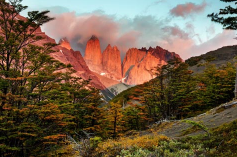Patagonia, Adorned in Autumn
巴塔哥尼亚,壮丽之秋
I was awakened in the predawn hours by a raging downpour. Cold, howling winds were coming off the lake, and the screen door to our half-domed shelter was flapping violently. Huddled with a few other hikers, I quickly realized the value of our lodging’s design: It’s one of the few structures that can withstand the extreme weather conditions that are a common occurrence in Patagonia. Thankfully, all of us — along with my camera gear — were safe and dry.
黎明时分,我被倾盆大雨惊醒。冷风从湖上呼啸而至,我们的半圆顶庇护所的纱门猛烈地摆动不已。和其他几个徒步者挤在一起,我很快意识到了这小屋的设计之妙:这是少数几种能够承受巴塔哥尼亚(Patagonia)常见极端天气的建筑之一。万幸的是,我们所有人——包括我的摄影器材——都安全、干爽。
But it was an ominous warning of what would become one of my most exhausting and exhilarating adventures as a travel photographer.
但这一不祥征兆,也预示着此行将成为我作为旅行摄影师生涯里最疲惫也最令人兴奋的冒险之一。
A day earlier, baqueanos — Chilean cowboys and cowgirls — had taken me and my guide on a three-hour horseback journey over mountains and across streams to a remote drop-off location. From there, we trekked over another set of mountains and streams for five more hours to reach the remote Valle del Frances, or French Valley, a stunning place nestled between jagged mountain peaks.
一天前,瓦奎诺人(即智利的男女牛仔)带着我和我的向导骑马走了三小时,我们翻山越岭,穿越溪流,来到一个偏远的落脚点。从那里出发,我们又在另一片群山溪流间跋涉了五个多小时,才抵达遥远的法兰西谷(Valle del Frances),这是一个坐落在锯齿状山峰间的绝美去处。

百内塔又名青塔,是巴塔哥尼亚的标志性山峰。(“百内”是特卫尔彻语中蓝色的意思。)
Our plan was to spend a couple of nights there, taking day hikes into the valley to see the waterfalls and gasp-worthy mountain vistas. As is often the case, however, the Patagonian weather forced us to change our plans.
我们计划在这里住上几天,白天到山谷里徒步,观赏瀑布和令人叹为观止的山景。然而不可避免的是,巴塔哥尼亚的天气迫使我们改变了计划。
Harassed by the storm, we hunkered down and waited for the unexpected squall to pass. But after a day with no relief in sight, we instead began planning our escape. But the swollen rivers were impassable, so the baqueanos couldn’t retrieve us. And the wind had created ocean-size waves in the lake, rendering boat travel too dangerous for rescue. We had only one way out: to trek 10 miles back to the lodge.
受暴风雨的阻挠,我们蜷缩在一起,想等这突如其来的狂风骤雨过去。但一天下来都没有任何缓和迹象,于是我们开始计划逃离。可暴涨的河水断去退路,瓦奎诺人接不到我们。狂风在湖中掀起滔天大浪,开船来救又过于危险。我们只有一条路可走:徒步16公里回到小屋。
This was no ordinary 10-mile hike. Hurricane-force winds required us to crawl up the mountainside. (Hiking upright with backpacks would have created sails and swept us off the mountain.) Crossing rivers required holding onto ropes with meticulous care, knowing that one misstep would result in our being washed away. Forget taking photos; it was impossible.
这可不是普通的徒步。飓风迫使我们在山上爬行。(背着包直立徒步会变成风帆,把人从山上卷下去。)过河时得小心翼翼抓住绳索,因为一个失误就可能会被水冲走。别惦记拍照了,那是不可能的任务。
As a photographer, I’d been intrigued by the remote and rugged Patagonia landscapes for many years, voraciously devouring articles and especially photographs from the region. In time, however, I realized that I seldom saw the place depicted in autumn. Snow-capped mountains, vast plains, windswept lakes, eye-catching cowboy outfits — they were almost always seen in summertime. I set out to create what I couldn’t find.
作为一名摄影师,多年来我一直对遥远而崎岖的巴塔哥尼亚风景着迷不已,如饥如渴地翻阅关于这里的各种文章,特别是照片。然而,随着时间的推移,我发现很少看到它秋天的样子。白雪皑皑的山脉,广袤的平原,狂风肆虐的湖泊,抓人眼球的牛仔服饰——几乎都是在夏天拍的。于是我准备去创造我没有看到过的东西。
To maximize the possibilities for seeing fall foliage, and accounting for the reversal of the seasons in the southern hemisphere, I planned my trip for mid-April. And as a base camp, I chose Las Torres Reserve, an eco-tourism destination in the heart of Torres del Paine National Park, in southern Chile.
为了尽可能看到秋日落叶景色,同时考虑到南半球的季节倒转,我计划在4月中旬出行。我选择拉斯·托雷斯保护区(Las Torres Reserve)作为大本营,这是一处生态旅游目的地,位于智利南部百内国家公园(Torres del Paine National Park)的中心地带。
The reserve offers a wide range of lodging options, including a luxury hotel, hostels for hikers in the backcountry and numerous campgrounds. Guests enjoy hiking and riding horses to iconic locations, including the three peaks of the Torres del Paine (“Towers of Blue”), Los Cuernos (“the Horns”) and the French Valley.
保护区提供多种多样的住宿选择,包括豪华酒店、针对徒步者的偏远旅社,以及许多露营地。旅客们喜爱徒步或骑马至地标景点,包括百内国家公园的三座山峰、百内角和法兰西谷。
As enamored as I was with the remote landscape and the extreme conditions, I became equally fascinated with the baqueanos and their culture. Nursing my sore legs and back from the epic hike, I spent a day at their ranch, in the barn and corral observing them and their interactions with the horses and guests.
我对瓦奎诺人和他们的文化,就像对这遥远风景和极端气候一样着迷。为了让漫长远足之后酸痛的双腿和后背得到恢复,我在他们的牧场停留了一天,在谷仓和畜栏里观察他们,以及他们与马匹和客人的互动。
Although I speak some Spanish, understanding their dialect and slang was virtually impossible. No matter — their nonverbal communication told me plenty.
虽然我会说一些西班牙语,但要理解他们的方言和俚语几乎是不可能的。也没关系——他们非语言性的交流已经让我明白了很多。
Baqueanos are descendants of the original horsemen who entered Patagonia more than a century ago. They sustain many of their ancestors’ traditions, including a unique clothing style and a unanimous love of yerba maté, an herbal tea, consumed throughout the day and communally shared.
瓦奎诺人是一个多世纪前来到巴塔哥尼亚的原始马背牧民的后裔。他们保留了许多祖先的传统,包括独特的服饰风格和对“yerba maté”的一致喜爱,这是一种草本茶,他们每天都在一起喝。
A genuine love for their horses was obvious. I watched for hours as baqueanos bathed, brushed and coddled the animals. They knew the horses as well as they knew their co-workers, calling their animals by name and in a tone suitable for each horse’s unique personality.
他们对马的真心喜爱是显而易见的。这些瓦奎诺人给马匹洗澡、刷毛、悉心照料它们时,我在一旁观察了好几个小时。他们对这些马匹就像对自己的搭档一样熟悉,用适合每匹马独特个性的语气来称呼它们的名字。
A few baqueanos live at Las Torres Reserve year round, while others are brought in from area ranches for seasonal work. Regardless of their tenures, they all appeared to endure some of the harshest weather on earth while providing expert care for the horses and the lodge guests.
少部分瓦奎诺人一年四季都生活在拉斯·托雷斯保护区,另一些人则是从当地牧场过来做季节性活计。无论在这里呆多久,他们似乎都要忍受地球上最恶劣的一些天气,同时还要为马匹和住宿旅客提供专业的照看服务。
As a travel photographer, I’ve come to realize that, the more challenging it is to get to a location, the fewer people who visit. And Patagonia is certainly hard to reach: It took a nine-hour flight from Miami to Santiago, Chile, followed by another four-hour flight to Punta Arenas in southern Chile, and finally a five-hour drive to Torres del Paine National Park.
作为旅行摄影师,我逐渐意识到,到达一处景点的难度越高,去的人也越少。到达巴塔哥尼亚的难度绝对很高:从迈阿密飞到智利的圣地亚哥需要九个小时,之后还要再飞四个小时到智利南部的蓬塔阿雷纳斯(Punta Arenas),最后再开车五个小时才能抵达百内国家公园。
I’ve also learned that it’s more rewarding if I take the time to experience a place rather than simply seeing it. And the baqueanos at Las Torres Reserve facilitated exactly that kind of meaningful cultural immersion.
我也发现,比起简单的走马观花,花时间体验一个地方会带来更大的收获。而让人体验到这种深刻文化沉浸的,正是拉斯·托雷斯保护区的瓦奎诺人。
来源:好英语网

参与评论